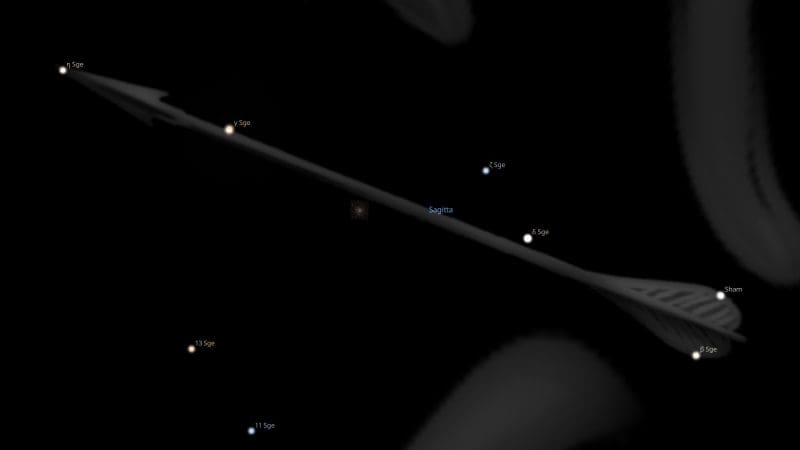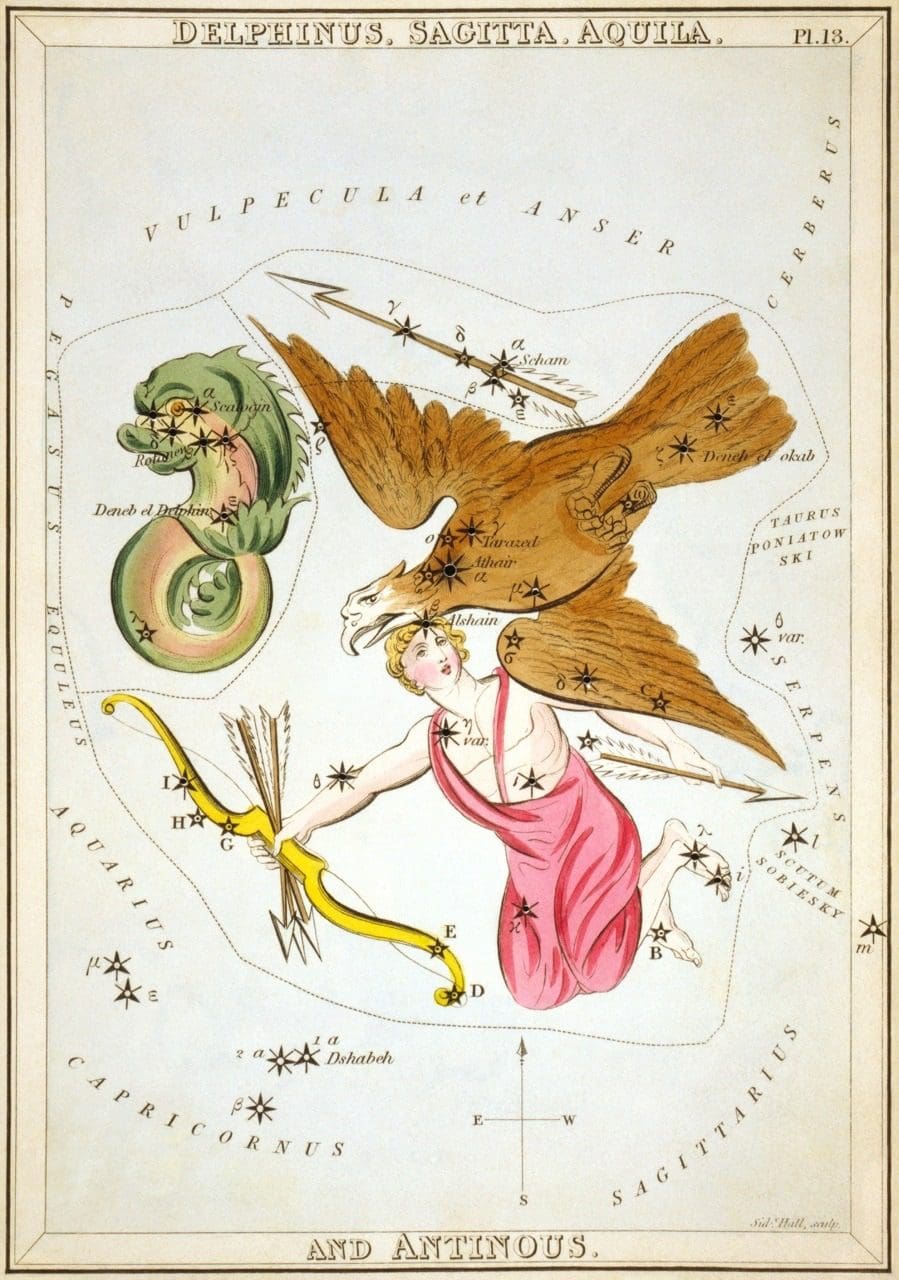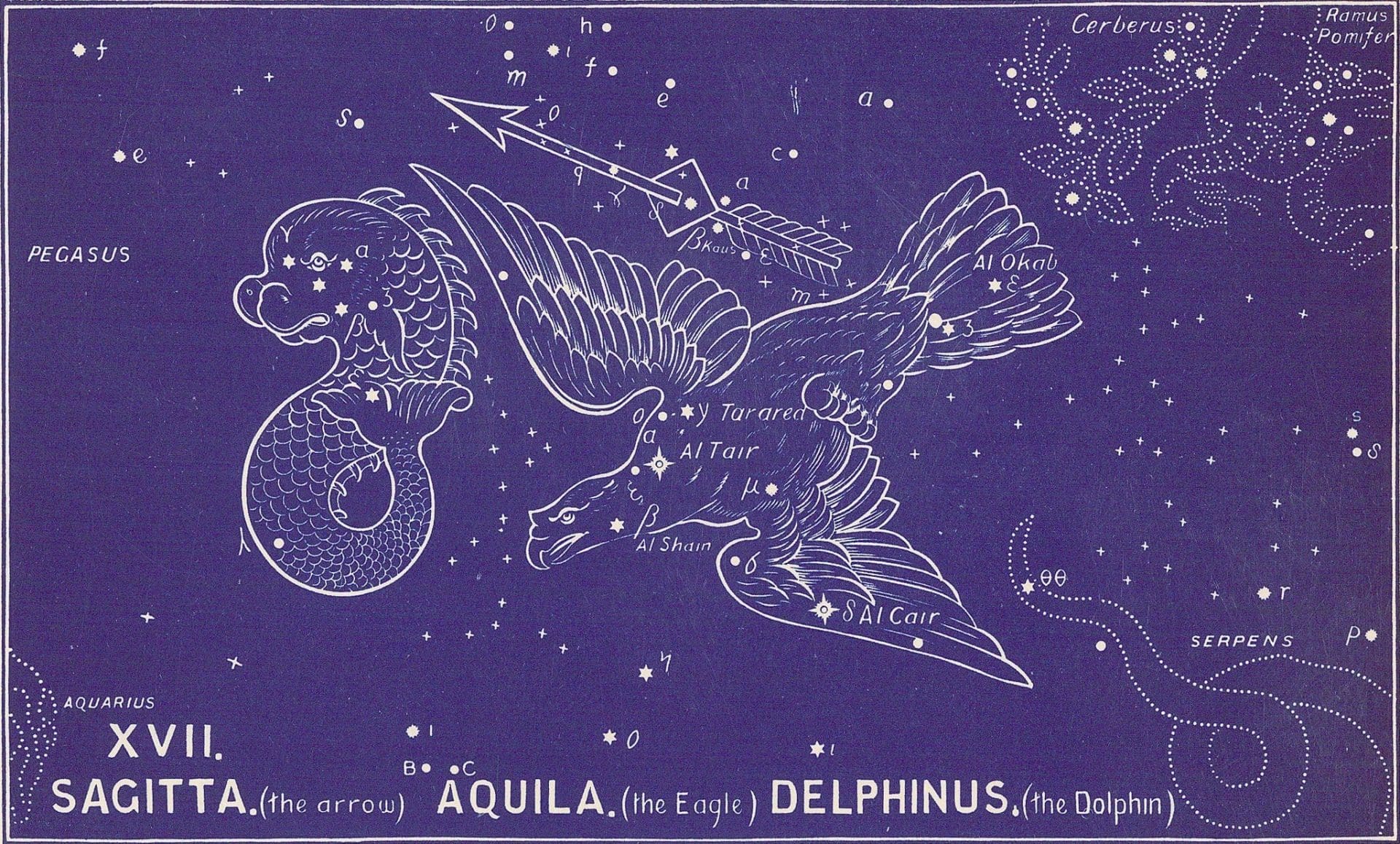FIXED STARS: Major Stars | 1000+ Stars | Constellations | About
Constellation Sagitta the Arrow is a northern constellation bordering Aquila, Cygnus and the obsolete constellation Cerberus.Sagitta is one of the 48 constellations listed by Ptolemy in the 2nd century and remains one of the 88 modern constellations. It spans over 9 degrees of the zodiac in the Sign of Aquarius.
Sagitta Constellation Stars
| 2000 | 2050 | Star | Name | Sp. Class | Mag. | Orb |
|---|---|---|---|---|---|---|
| 01♒04 | 01♒46 | α Sge | Sham | G1 | 4.38 | 1°10′ |
| 01♒12 | 01♒54 | β Sge | G8 | 4.38 | 1°10′ | |
| 03♒23 | 04♒05 | δ Sge | M2 | 3.82 | 1°30′ | |
| 04♒02 | 04♒44 | ζ Sge | A3 | 5.01 | 1°00′ | |
| 07♒02 | 07♒44 | γ Sge | M0 | 3.51 | 1°40′ | |
| 09♒05 | 09♒47 | η Sge | K2 | 5.09 | 1°00′ |
α Sge is officially named Sham. Applied in recent times from the Arabic constellation name al-sahm, “the Arrow,” for Sagitta. [1]
Sagitta Astrology
Manilius
Sagitta, The Arrow, will bestow the skill of hurling the javelin with the arm, of shooting the arrow from the string and missiles from rods, and of hitting a bird on the wing in the sky that is its home or piercing with three-pronged spear the fish that deemed itself so safe. What constellation or nativity should I rather have given Teucer? To what degree should I prefer to assign Philoctetes? His bow enabled Teucer to repel the flaming torches of Hector which threatened to pour fell fire upon a thousand ships. Carrying in his quiver the fate of Troy and the Trojan War, Philoctetes, who tarried in exile, proved a foe more potent than an armored host.
Under this constellation indeed may well have been born that luckless parent who caught sight of a serpent couched upon his son’s face and sapping the life-blood of the sleeping child, but nerved himself to let fly a shaft at it and succeeded in killing the reptile. Fatherhood supplied his skill; a natural instinct overcame the danger and delivered the boy from sleep and death alike, given then a second life and snatched whilst dreaming from the grave. [2]
Maternus
Sagitta (α Sge?) rises in the eighth degree of Libra. The one who is born in this sign will be a shooter of arrows. He hits flying birds with unique skill or spears fish with a three-pronged spear. But if this star is found on the descendant and malefic and benefic planets aspect it equally, the native will be drafted into the army, placed in line of battle, and will die amid flowing blood and heaps of enemy dead. If Mars alone or with Mercury is in aspect or in conjunction with this place, the natives will be sold as gladiators and die from loss of blood for the pleasure of the spectators. But if Saturn is in aspect, they become gladiators by sentence of the court. The River Styx is said to be in this degree. Those who have the ascendant in the eighth degree (α Sge?) will be bath attendants or common servants. [3]
Robson
Legend. Sagitta represents the arrow with which Hercules slew the eagle that fed upon the liver of Prometheus.
Influence. According to Ptolemy this constellation is like Saturn and moderately like Venus, but Bayer states that it is of the nature of Mars and Venus. It is said to give a keen mind with ability for abstract thought and teaching or writing, irritability, jealousy and danger of hostility and bodily harm. [4]
Noonan
There is only one named star in this constellation, now called Sagitta (Sge). Ptolemy mentions that its stars are as Mars, and to some degree Venus.
Maternus asserts in his Mathesis that the constellation, probably meaning the star Sham, portends one who will be a successful hunter. If setting, the star indicates one who will be drafted into the army and die in battle, or who will die as a gladiator. But see below for another interpretation.
While little has been written about this constellation and its stars, we can still say a great deal by applying the basic principles of classical astrology. Its effects will certainly concern the weather, and in a geneathical chart the quality of the mind will be indicated. The tip of the arrow [η Sge] is a K5 spectrum star, and the next closest one in the shaft [γ Sge] has a double M0-A0 spectra. The tip, therefore, has the nature of Mars (Saturn) and somewhat Venus. Here you will find violence and bodily harm, possibly as a result of jealousy.
The end of the shaft is dominated by α-Sge and β-Sge Saggitae, GO and KO stars, respectively. This combination of Mars and the Sun in a constellation such as The Arrow will result in a keen mind and a great deal of intellectual energy, but with the obvious tendency to be combative and opinionated. This same excess of the element heat will also result in rather violent weather if occurring in significant places in a chart of the new or full Moon. [5]
Allen
Sagitta, the Arrow, lies in the Milky Way, directly north of Aquila and south of Cygnus, pointing eastward; and, although ancient, is insignificant, for it has no star larger than the 4th magnitude, and none that is named.
It has occasionally been drawn as held in the Eagle’s talons, for the bird was armor-bearer to Jove; but Eratosthenes described it separately, as Aratos had done, and as it now is on our maps. It has been regarded as the traditional weapon that slew the eagle of Jove, or the one shot by Hercules towards the adjacent Stymphalian birds, and still lying between them, whence the title Herculea; but Eratosthenes claimed it as the arrow with which Apollo exterminated the Cyclopes; and it sometimes was the Arrow of Cupid. The Hyginus of 1488 showed it overlying a bow; indeed, Eratosthenes called it toxon, a Bow, signifying Arrows in its plural form; Aratos mentioned it as the Feathered Arrow and the Well-shaped Dart, the allos oistos, of our motto, “another arrow,” in distinction from that of Sagittarius. Still, it has often been thought of as the latter’s weapon strayed from its owner. Hipparchos and Ptolemy had plain oistos.
Bayer, who ascribed to it the astrological nature of Mars and Venus, picked up several strange names: Daemon, Feluco, and Fossorium, apparently unintelligible here; Obelus, one of the semeiai, or notae, of ancient grammarians, or, possibly, an Obelisk, which it may resemble; Orfercalim, cited by Riccioli and Beigel from Albumasar for the Turkish Otysys Kalem, a Smooth Arrow; Temo meridianus, the Southern Beam; Vectis, a Pole; Virga and Virgula jacens, a Falling Wand.
Originally only 4° in length, modern astronomy has stretched the constellation to more than 10°; Argelander assigning to it 16 naked-eye stars, and Heis 18. Eratosthenes gave it only 4. [6]
Bullinger
It is not the Arrow of Sagittarius, for that has not left his bow. There are about 18 stars of which four are of the 4th magnitude. Only γ and δ are in the same line, while the shaft passes between α and β. The Hebrew name is Sham, destroying, or desolate. [7]
References
- A Dictionary of Modern Star Names, Kunitzch, Smart, 2006, p. 51.
- Astronomica, Manilius, 1st century AD, book 5, p.235.
- Mathesis: Liber Octavus, Firmicus Maternus, 4th Century AD, p.277, 290.
- Fixed Stars and Constellations in Astrology, Vivian E. Robson, 1923, p.59.
- Fixed Stars and Judicial Astrology, George Noonan, 1990, p.24-26.
- Star Names: Their Lore and Meaning, Richard H. Allen, 1889, p.349-351.
- The Witness of the Stars, E. W. Bullinger, 1893, Sagitta (the Arrow).
[wp_ad_camp_3]


